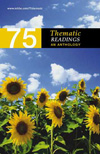
Plato |  |
PlatoPlato, "Allegory of the Cave" Plato (428-347 B.C.) was the student of Socrates, the teacher of
Aristotle, and one of the most important thinkers who ever lived. Plato,
among many other things, can be seen as the father of the Idealist school
of philosophy. This philosophical system attempted to show a rational
relationship between people, government, and the universe, ruled by the
ideals of what is good, true, and beautiful. Basic tenets of this branch
of philosophy are that anything we perceive is but a mere reflection of
the truth, and that the interaction of the ideal version and the perceived
thing determine human consciousness. Plato's dialogue "Allegory of
the Cave" is taken from the Republic. Here, Socrates, who
is endeavoring to determine the relationship between the "real world"
and our perception of it, is the dialectic questioner of Glaucon. | QUESTIONS FOR DISCUSSION | CONTENT - What is the only thing the prisoners can see?
- Describe the central image mentioned in paragraph one.
- For the prisoners, what constitutes the truth?
- According to Plato, in the world of knowledge what idea "appears
last of all"?
- Who is Homer?
- What are the two kinds of "bewilderments of the eyes"
that Plato describes? What are their two causes?
- Describe the process a liberated prisoner undergoes. What changes
in perception take place? What happens when he goes back down to the
cave?
STRATEGY AND STYLE - Where in this dialogue does Plato put the whole allegory together?
Discuss the function of the relevant paragraph in light of this placement.
What comes after this paragraph?
- Discuss this piece as a process essay. What process is being explained,
and how does Plato analyze it? What types of support does he provide
for his main points?
- Characterize Glaucon's role in this dialogue. What work do his
remarks do here? Whose voice do you suppose his is?
| ENGAGING THE TEXT | - Draw a picture of Plato's cave and its inhabitants. Did this exercise
change the way you looked at this reading? Explain.
- Recall a situation when you felt you observed something clearly,
but it turned out to be quite different from you thought it was in the
first place. How can you tie in this memory with "The Allegory
of the Cave"?
| SUGGESTIONS FOR SUSTAINED WRITING | - Pick one of the major oppositions presented in this essay—illusion/reality,
light/dark, high/low—and write a comparison/contrast essay exploring
the nature of that duality. Incorporate Plato's ideas and your own insights
into your writing.
- Why are we still reading Plato? How are his ideas still relevant
today? Take the central concept that we are still prisoners to the "world
of sight" and write an essay exploring this idea in modern times.
| FOR FURTHER RESEARCH | Do some research to find one philosopher within the past five hundred
years who was deeply influenced by Plato, and whose work interests you.
Which philosopher did you pick? When did he or she live? What was Plato's
main influence on his or her work? What did your philosopher add to the
discussion? | WEB CONNECTION | To understand a writer's work often it's important to understand something
about where he or she lived and worked. To help you deepen your understanding
of Plato in this regard, here's the homepage
for a website dealing with ancient Athens. | LINKS | Biographical This is a good
start page for Plato. Here, you'll find a detailed biography with
embedded links and some links to other Plato pages on the Web. It's
a good place to start your internet research. Here's a biography
from ThinkQuest.org, which is split up into different thematic categories.
It starts with a personal history and then examines how Plato viewed
things such as freedom and morality. How trustworthy is the information
here? How can you tell? Wondering what the great philosopher might have looked like? Here's
a photo of a bust
of Plato in the Vatican Museum.
Bibliographical Here's "The
Cave" in etext. This is the Jowett translation, and it includes
links to related Internet resources. Take a look at it and see if working
with etext offers you any advantage over using hard copy. Here is The
Dialogues of Plato in etext, from the Electronic Text Center
at the University of Virginia Library. Do you consider this a reliable
text? Why or why not? How can you tell? Hungry for more online reading? Well, here's a large list
of Plato's works that can be found on the Internet.
Cultural If you'd like to zero in on one aspect of Athens and visualize
it, here are some maps
and drawings of the Acropolis and the Theater of Dionysus. Interested in putting the writings of Plato into a political context?
This is the Columbia
Encyclopedia entry for the Thirty Tyrants. Did you click on the
embedded links found there, too? How does Plato figure in here? Here is a reproduction of The
School of Athens by Raphael, as well as some info about the
painting. Where are Plato and Aristotle found in the painting? What
do you make of their placement?
|
|
|
|